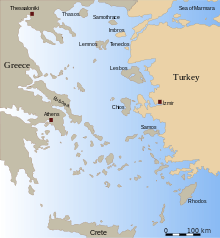Syros
| Syros Περιφερειακή ενότητα Σύρου Δήμος Σύρου-Ερμούπολης | |
|---|---|
| Regional unit | |
|
Ermoupoli and Ano Syros | |
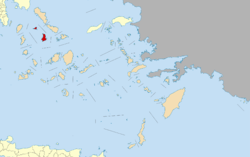 Syros within the South Aegean | |
| Coordinates: GR 37°27′N 24°54′E / 37.450°N 24.900°ECoordinates: GR 37°27′N 24°54′E / 37.450°N 24.900°E | |
| Country | Greece |
| Region | South Aegean |
| Capital | Ermoupoli |
| Area | |
| • Total | 83.6 km2 (32.3 sq mi) |
| Population (2011)[1] | |
| • Total | 21,507 |
| • Density | 260/km2 (670/sq mi) |
| Postal codes | 841 xx |
| Area codes | 228x0 |
| Car plates | EM |
Syros (/ˈsaɪrɒs, -roʊs/; Greek: Σύρος), or Siros or Syra is a Greek island in the Cyclades, in the Aegean Sea. It is located 78 nautical miles (144 km) south-east of Athens. The area of the island is 83.6 km2 (32 sq mi) and it has 21,507 inhabitants (2011 census).[1]
The largest towns are Ermoupoli, Ano Syros, and Vari. Ermoupoli is the capital of the island and of the Cyclades. It has always been a significant port town, and during the 19th century it was even more significant than Piraeus. Other villages are Galissas, Foinikas, Pagos, Manna, Kini and Poseidonia.
Syros (Greek: ΣΥΡΟΣ) also refers to USS LST-325, which is an American made World War II-era tank landing ship that was sent to Greece on 1 September 1964, as part of the grant-in-aid program. She served in the Hellenic Navy as RHS Syros (L-144) from 1964 to 1999. It is now decommissioned and docked in Evansville, Indiana.
Ermoupoli
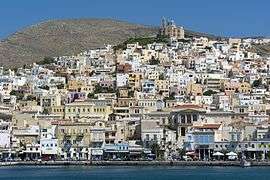
Ermoupoli (Greek: Ερμούπολη) stands on a naturally amphitheatrical site, with neo-classical buildings, old mansions and white houses cascading down to the harbour. The City Hall, where Miaoulis Square lies ringed with cafes and with seating areas under palm trees. The "City of Hermes" has numerous churches, including Metamorphosis, Koimisis, St. Demetrius, Three Hierarchs, Anastasis, Evangelistria and St. Nicolas. The Archaeological Museum has many finds and the Municipal Library contains numerous editions. The quarter of the town known as Vaporia is where the sea captains lived. Along its narrow streets, stand numerous neo-classical mansions.
Ano Syros
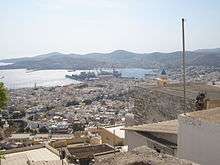
Ano Syros is the second town of Syros and was built by the Venetians at the beginning of the 13th century on the hill of San Giorgio, north-west of Hermoupolis. Ano Syros maintains a medieval atmosphere. Innumerable steps between narrow streets and houses with coloured doors lead to the top of the town. The medieval settlement of Ano Syros is accessible by car; the town is served mostly by marble steps. The distance from the harbour up to the main entry point of the town is approximately 1000 metres. The Catholic cathedral of Saint George dominates Ano Syros. The cathedral church was constructed during the 13th century. From the cathedral visitors have a panoramic view of the neighbouring islands of Tinos, Delos, Mykonos, Paros, Andros and Naxos.
History
Kastri culture
The history of settlement on Syros goes back at least 5,000 years, to the Early Bronze Age of the Cycladic civilization. This is when the hill-top settlement of Kastri (Syros) began. Archaeologists describe Early Cycladic III (ECIII) culture as Kastri culture.
Kastri, dated by archaeologists to 2800-2300 BC, was one of the earliest settlements in Greece that were protected by stone walls with rounded bastions. Also the cemetery of Chalandriani is associated with Kastri. Inside the fortification, the houses shared party walls and were packed close together. It is estimates that the fortified town was home to up to 300 people.
The site was first discovered and excavated in 1898 by Christos Tsountas, the "father of Cycladic research". Kastri had some of the earliest metalwork in the region, and also some of the earliest use of potter's wheel.
Antiquity

Throughout history, the island was knowns as Syra, then Syros or Siros. In later times, it appears to have been inhabited by the Phoenicians. In the Odyssey, Syros was the country of the swineherd Eumaeus who described it at length (Odyssey, XV, 403 sq.).
The island was also the home of the philosopher Pherecydes, the teacher of Pythagoras. It possessed two leading cities, Syros (now the modern Ermoupoli) and another city on the western coast where stands to-day Galissas.
The island did not play an important role during antiquity nor the early Christian years , it was not even a diocese at a time when even the smallest island possessed its bishop. During Roman times the capital of Syros was situated in the area of contemporary Ermoupoli.
Middle Ages


At the end of ancient times, barbarian raids and piracy, which affected the Aegean for many centuries, led Syros to decline. The island, along with the other Cyclades, was devastated several times during the Middle Ages by raiders from different directions including Sicilians, Arabs, Turks, and Venetians.
In the Byzantine years Syros constituted part of the Theme of the Aegean Sea, along with the rest of the Cycladic islands. After the overthrow of Byzantium in the Fourth Crusade by the Venetians and Franks in 1204, the island was definitively conquered by the Venetians under the leadership of Marco Sanudo. As part of the Duchy of the Archipelago, Syros would remain under Venetian rule until 1522.
It was at this time that Ano Syros was founded. During the Latin period, the majority of the local community were Roman Catholics, but maintained the Greek language. During the reign of almost three and a half centuries of the Duchy of the Archipelago, Syros had a singular feudal regime.
Ottoman Era
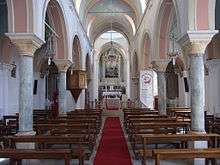
By the 16th century, the Ottoman fleet became dominant in the Aegean and the Duchy fell apart. In 1522 the corsair Barbarossa took possession of the island, which would be known as "Sire" during Ottoman rule.[2] However, negotiations of the local authorities with the Ottomans gave the Cyclades substantial privileges, such as the reduction of taxes and religious freedom.
At the same time, following an agreement of France and the Holy See with the Ottoman authorities, the Catholics of the island came under the protection of France and Rome .
The Roman Catholic diocese of Syros was a Latin diocese, suffragan of Naxos. The Venetians had established there a Latin bishopric which was subject to the Latin Archbishopric of Athens until 1525. From the time of the island's occupation by the Turks in the 16th century, the Greeks established an Orthodox metropolitan on Syros: Joseph[3] is the earliest known, along with Symeon who died in 1594[4] and Ignatius in 1596.[5] The island became for the most part Catholic.[6]
The list of titular bishops may be found in Le Quien[7] and in Eubel.[8] The most celebrated among them is John Andrew Carga, whom the Turks strangled in 1617 because he refused to convert to Islam and because he was helping the Greek revolutionaries hiding on the island.[9]
After the second half of the 17th century, a period of economic recovery of the Aegean began, climaxing during the transition from the 18th to the 19th century. The special regime of the islands allowed the development of local self-government. The decline of piracy since the beginning of the 19th century led to the gradual liberation of the sea routes of the Eastern Mediterranean
In Independent Greece
Greek War of Independence
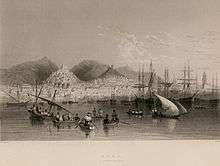
Due to its crucial geographical position, Syros became known as a maritime way-point. Moreover, the special social, religious and institutional conditions prevailing on the island led Syriots to neutrality at the beginning of the Greek Revolution in 1821, and they did not take part in the Greek revolt. As a result, Syros became a secure shelter during the Revolution, attracting many Greek refugees from Asia Minor, Chios, Spetses, Psara, Aivali, Smyrna, Kydonia, Kassos and other places.
19th century
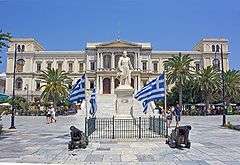
After 1829 it was incorporated in the newly founded Hellenic kingdom. The island returned to peace and tranquility, Syros became known as a cross-road in the Aegean and as an international commercial center linking Western Europe and the Mediterranean sea to the East. The construction of the first buildings began in 1822, and in 1824 the first Orthodox Church Metamorphosis and the largest Greek sanatorium was constructed.

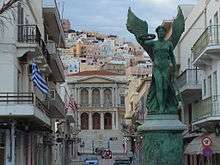
With the foundation of the Greek state, the Catholic population of the island was hellenized and changed their Latin family names to Greek ones, (e.g. the family name Vuccino to Voutsinos, Russo to Roussos, Vacondio to Vakondios, Daleggio to Dalezios, Salsa to Salsapoulos, Freri to Freris just to mention a few).
However, there was no problem of integration between the old residents of Syros, mostly Roman Catholics and the newly arrived refugees, mostly Greek Orthodox. Because of the Venetian domination from the Middle Ages and onwards, the islanders had been exclusively Roman Catholic. However, due to immigration from other islands, Catholics now constitute some 47% of the population. The majority of the population are Greek Orthodox. They live peacefully side by side. Intermarriage between Churches is very common in Syros.
During 1831 Syros played a prominent role in the elaboration of the new Greek Constitution. Under Ioannis Kapodistrias (Giovanni Capo D'Istria), the first Governor of the new state, the population of Ermoupolis had reached 13,805 residents and the city had evolved into a seat of government.
It had a Commercial Court of Law, a post office (one of the first in Greece), insurance brokerages, the first public school, a branch of the National Bank of Greece, art gallery, museum, library, a social club for the elite society etc. However, in 1854 cholera and a series of other epidemics unfortunately plunged Syros into mourning. A number of charitable institutions for public health and social services were established during this period: orphanages, poorhouses and a mental hospital.
Newcomers, mainly mariners and tradesmen, gave the island a new dynamic, which along with its demographic and economic development, turned it into an administrative and cultural centre. Newcomers flocked to the island and founded the town of Ermoupoli, which rapidly became the leading port of Greece.
Between 1822 and 1865, Ermoupoli was rebuilt in a Neoclassical style, merging Greek Classicism with elements of the Renaissance. Many landmarks such as the City Hall (designed by the famous German architect Ernst Ziller), the Apollo Theatre by the Italian architect Pietro Campo (a miniature version of the La Scala in Milano), the main Library, the General Hospital of Syros (Vardakeio-Proio), Miaoulis square and other buildings were built during that period of time.
The European architects (mainly Germans and Italians) and also Greeks who participated in the design and planning of Ermoupolis respected the classical and ancient Greek architecture and harmonized it with the romanticism of the West. Ermoupoli has a high density of neoclassical architecture. The prosperity of Syros was connected with the development of social and cultural life. The evolutionary cycle was completed with the creation of the first industrial units during the decade of 1860–70.
Most public buildings, churches, schools, stadiums and many mansions were built in the same elegant and neoclassical style, making Ermoupoli at the time a very modern city with a unique character. As a result, Syros changed almost overnight from a rather quiet island into a vigorous centre of crafts, industry and production. Also, due to its large port of Ermoupoli, it turned into a major centre for ship building and refitting. Neorion was the first shipyard of Greece. To this very day, it remains a place where many ships are serviced and refitted.
Since 1830 the commerce of fabrics, silk, ship building, leather and iron developed on Syros and at the same time a powerful banking system was created. The tremendous growth and development of Ermoupolis continued and until 1860 Syros was the most important commercial harbour in Greece. Together with commerce and ship building, construction and public works were also developed. The Greek Steamship Company was founded in 1856.
A period of decline then followed, as sailing gave way to steam, the importance of the geographical situation of the island was reduced and Piraeus harbour finally took the predominant position in Greece - with the competition of Patras also reducing Syros' commercial importance.
20th century
Beginning at the end of the 19th century and for several decades, a temporary economic recovery took place, due to the development of the textile industry ("Foustanos-Karellas-Velissaropoulos & Co").
The Second World War reduced Syros' economic development, as was the case for every economic centre in Greece. However, already since the 1980s, along with the generalized economic recovery and the rise of the living standards in Greece, elements of improvement appeared with tourism as its central axis. At the same time, the re-opening of the Neorion shipyards, as well as a number of other activities, indicate that Syros is on an upward trend.
Ermoupoli today has 7 elementary schools, 2 junior high schools, 2 high schools, 2 technical schools and the Aegean University with a department of Fine Arts and system design, with a proposed future addition in Applied Arts and Visual Arts. The Syros Island National Airport, the Aegean casino, the frequent passenger boat transportation system and all other modern amenities help to attract many domestic and foreign tourists to the island all year round.
Syros also has a British cemetery where various people are buried, including many seamen and servicemen who died in the Cyclades region, particularly during the Second World War. The numerous consulates of countries such as France, Britain, Italy, the Netherlands and Scandinavian countries bear witness to the connection of Syros with the wider European scene.
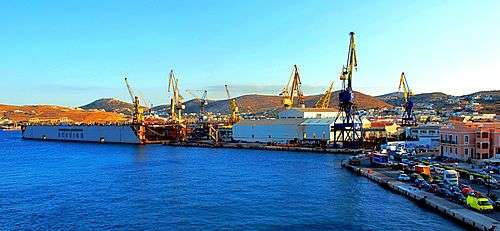
Administration

Syros is a separate regional unit of the South Aegean region. The only municipality of the regional unit is Syros-Ermoupoli. As a part of the 2011 Kallikratis government reform, the regional unit Syros was created out of part of the former Cyclades Prefecture. At the same reform, the municipality Syros-Ermoupoli was created out of the 3 former municipalities: [10]
The municipality also includes the uninhabited island Gyaros and several other islets. The total area of the municipality is 102.4 km2 (40 sq mi).
Province
The province of Syros (Greek: Επαρχία Σύρου) was one of the provinces of the Cyclades Prefecture. Its territory corresponded with that of the current regional units Syros and Mykonos.[11] It was abolished in 2006.
Religion
As in the rest of Greece, Syros has Eastern Orthodox churches. Metamorphosis is the most important Orthodox church on the island, Kimisis tis Theotokou is also significant and noted for the fact that it hosts a masterpiece by painter El Greco.[12] There is also an equal number of Roman Catholic churches on the island and some entirely Catholic villages; thus, it is one of the most significant places for Roman Catholicism in Greece.[12] Syros is one of a few places where Catholics and Orthodox share a common date for Easter, which in Syros' case, is the Orthodox date.[13]
The Catholic diocese numbers 9000 worshippers, 21 secular priests and 8 regulars, 7 parishes, 7 churches with a resident priest, 3 without a priest, and 56 chapels. The Capuchins and Jesuits each have an establishment; the Sisters of Charity, 2 houses, one of which is a hospital; the Sisters of St Joseph of the Apparition have a boarding school and St George, a De La Salle Public School. There is also a single church of the Catholic Byzantine rite, not part of the diocese but subject to the Byzantine Exarchate of Greece.
Cuisine
Local specialities of the island include:
- Kaparosalata (salad with capers)
- Maintanosalata (salad with parsley)
- Frisoura (appetizer)
- Delagraciano
- Ladopita
- Marathopita
- Sfougato
- San Michali cheese
- Loukoumi (dessert)
Sports
- Foinikas Syros V.C.
- Aris Syros, basketball/volleyball
- Hellas Syros, football
- Athletic Club Syros, basketball/football
- 15th - 19th Sep 2016 30th World Underwater Spearfishing Championship [14]
Airport
Notable residents
- Eumaeus, character in the Odyssey
- Pherecydes (c. 600-550 BC), philosopher
- Demetrius Vikelas (1835–1908), writer and the first president of the International Olympic Committee
- Emmanuel Roidis (1836–1904), writer and journalist
- Giorgos Souris (1853-1919), satirical poet
- Stamata Revithi (1866-?), the first woman to compete in the Olympic Games and run the Marathon
- Antonio Gregorio Vuccino (Voutsinos) A.A. (1891–1968), Archbishop of Corfu, Zante and Cefalonia, Greece
- Markos Vamvakaris (1905–1972) musician
- Capt. John T. Vatis (1919-2002) Shipowner, international yacht racer
- Anastassios "Tassi" Vatis (1921-2000) Indy Racecar team owner, Shipowner
- Sir Richard Musgrave, Bt 1922-2000
- Manos Eleftheriou, lyricist
- Olga Broumas (1949-), poet and translator
- Stelios Mainas (1957-), actor
Gallery
 Statue of Andreas Miaoulis
Statue of Andreas Miaoulis- View from Ano Syros
 Ermoupoli market shop
Ermoupoli market shop A statue at Kini beach
A statue at Kini beach
See also
References
- 1 2 Detailed census results 2011 (Greek)
- ↑ http://www.turkcebilgi.com/ege_adalar%C4%B1/ansiklopedi Ege Adaları
- ↑ Le Quien, op. cit., II, 233
- ↑ Ampelas, Histoire de Syros, 411
- ↑ Miklosich and Mueller, "Acta patriarchatus constantinopolitani", V, 461
- ↑ Ricaut, "Histoire de l'estat présent de l"Eglise grecque", 361; Hilaire de Barenton, "La France Catholique en Orient", 171-173
- ↑ Oriens christianus, III, 865-868
- ↑ Hierarchia catholica medii aevi, I, 492; II, 267; III, 324
- ↑ Pétridès in "Revue de l'Orient chrétien", V, 407-422
- ↑ "Kallikratis reform law text" (PDF).
- ↑ "Detailed census results 1991" (PDF). (39 MB) (Greek) (French)
- 1 2 "Syros Churches: Information about the churches of Syros Greece, Cyclades". Greeka.com. 20 November 2007.
- ↑ "Easter: A date with God". The Economist. April 20, 2011. Retrieved 2011-04-23.
Only in a handful of places do Easter celebrants alter their own arrangements to take account of their neighbours. Finland’s Orthodox Christians mark Easter on the Western date. And on the Greek island of Syros, a Papist stronghold, Catholics and Orthodox alike march to Orthodox time. The spectacular public commemorations, involving flower-strewn funeral biers on Good Friday and fireworks on Saturday night, bring the islanders together, rather than highlighting division.
- ↑ proaction Kft. "30th World Underwater Spearfishing Championship". Cmas.org.
External links
- Official website of Municipality of Áno Sýros (Greek)
- Official website of Municipality of Ermoúpoli (English) (Greek)
- University of the Aegean in Ermoúpoli (English) (Greek)
- Department of Product and Systems design from University of the Aegean
- Information about Syros from syros-online.com (German)
- Syros The Official website of the Greek National Tourism Organisation
- Festival of the Aegean (Official website of the music festival that has been held on the island since 2005.)
- Complete travel guide for Syros island (English) (Greek)



